If you want to enjoy the best all inclusive China Tour, you can choose us as we can offer you 15 days tour. During the journey, you will across from the north to the south of China. We will begin the tour in Beijing and end in Shanghai. In the 15 days all inclusive china tour package, you will have an opportunity to take a rickshaw in old Hutong in Beijing. Besides, you will experience not only traditional Chinese culture but also China and foreign culture fusion on the Silk Road. At last, are you interested in visiting one of the most international cities and enjoy the Shanghai all inclusive china tour? If your answer is “yes”, then, our all inclusive tour is most suitable for you. Shanghai has combined both Chinese ways and foreign styles in food, clothes, and architecture. Don’t hesitate! All you have to do is just join us by starting this perfect all inclusive China tour.

Today you will arrive in Beijing, and your local tour guide will pick you up at the airport. Then you will be transferred to the hotel for a good rest.
Beijing is the capital of China. It covers a total area of 16,410 square kilometers. According to the 2020 Census, it has a population of more than 21 million. If you come to Beijing, you will surely marvel at its rich history and fantastic culture. Beijing has a history of over 3,000 years. In history, Beijing was once the capital of six dynasties. Many magnificent palaces have been built in the past 2,000 years, making Beijing enjoy the most imperial palaces, gardens, temples, and tombs in China. In the following two days, you will have opportunities to visit the famous attractions in Beijing. You will have a great time here.
This morning, we will go to Tian’anmen Square. It covers a total area of 4,800 square meters and can accommodate 1 million people for grand gatherings. Many important activities were held here, such as the 70th Anniversary of the People’s Republic of China, the Founding Ceremony of the People’s Republic of China, and memorial ceremonies of some important political leaders. In the middle of the Tian’anmen Rostrum is a large picture of Mao Zedong, the first chairman of China. The picture weighs about 1.5 tons. What’s more, China’s national emblem hangs over the Tian’anmen Rostrum. The design of the emblem consists of Tian’anmen Rostrum, the national flag, a gear, ears of wheat, and red ribbons, which all have symbolic meanings. Tian’anmen Rostrum embodies the revolution and national spirit of the Chinese people and it is also a symbol of Beijing, the capital of China. The patterns of the national flag symbolize the great unity of the Chinese people under the leadership of the Communist Party of China; the gear and ears of wheat refer to the alliance of workers and peasants under the leadership of the working class. The color of red and gold reflects the tradition of the Chinese nation. On the one hand, the red color is commonly used in festivals to make joyful culture. On the other hand, gold color means solemnity and dignity in China.
Then continue going north and you will come to the Forbidden City (closed each Monday), the Chinese imperial palace during the Ming (1368-1644), and the Qing (1363-1912) Dynasties. The Forbidden City covers an area of 720,000 square meters, which is equivalent to the area of one and the half Vatican. Constructed in 1420, it is China’s best-preserved imperial palace and the largest ancient palatial structure in the world. You can see imperial living and governing areas for emperors, valuable artworks, and royal gardens in the Forbidden City. Are you interested in it? Let’s go there and experience the traditional Chinese art and culture.
After lunch, we will visit the Temple of Heaven, where emperors offered sacrifices to heaven in ancient times. The temple of Heaven has an outer wall and an inner wall. The north wall has a round form and the south has a square shape. This also implies Chinese people’s belief that heaven is round while the ground is square. Each wall has three doors of different sizes. As the middle door was for the emperor, it is very tall. Other officials could only pass through the small doors on two sides. If you continue moving ahead, you can pay attention to the number of steps. You may find it is very interesting that the numbers of steps are nine or multiples of the number nine. Why? Is it a coincidence? Of course not. It is because ancient Chinese people consider the number nine as the largest number. So, they use the number nine to show the supreme power of the emperor. Therefore, the number of steps is nine, which can add eminence to the magnificent temple.
After visiting the Temple of Heaven, you will go to the Summer Palace. It covers a total area of 3 square kilometers and consists of the political governing area, the living area of the emperor and his empress as well as the scenic area. There are two pairs of bronze censers in the shape of dragon and phoenix in front of the Hall of Benevolence & Longevity. According to the ancient rites, the dragon has to be in the middle, symbolizing the emperor, and the phoenix should be on the two sides, symbolizing the empress. However, you can see the censers here are different from the previous ones. Here it is the dragon that is on both sides while the two phoenixes are in the middle. Why? Because in the late Qing Dynasty, the emperor at that time was like a puppet, and the Empress Dowager Cixi was the one who really held power. Therefore, the decorations like the censers further highlight the status of the phoenix and the empress. There are also many valuable artworks, delicate rooms, and beautiful scenery in other areas. What are you waiting for? Let’s go to explore it!
At night, you will have Peking Roast Duck, a fixed item of dinner on any Beijing tour itinerary. For our ordinary guests, Beijing Roast Duck is an option or they need to pay extra for it. But the meal is a must-eat in our all inclusive China tour and you don’t have to pay more. Peking roast duck is always served in well-cut slices. It has crisp skin and tender meat. Have you already thought of the mouthwatering duck? I bet you will like it!
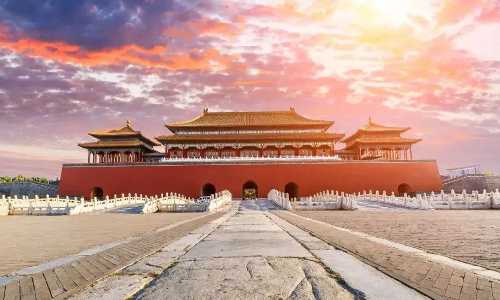
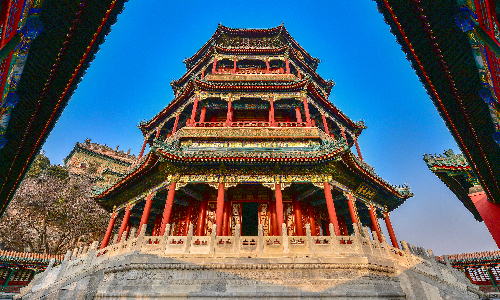
This morning, we will go to visit the Hutongs by rickshaw. There are thousands of Hutongs of different lengths and widths in Beijing. Hutong is not only the venation of the city but also the place where traditional Beijingers live. Taking a rickshaw is the most traditional and relaxing way to experience the old Beijing and Hutong culture. The rickshaw was first put into use and served as a major means of transportation from the late 19th century. This kind of transportation mainly depends on human labor. Generally, it can take one to two people. Nowadays, cars are the main means of transportation for people to travel. And you can only see the rickshaw at tourist attractions.
Then we will visit the Lama Temple. Built in 1694, it was originally the residence of princes. In 1744, Emperor Qianlong converted it into a temple of Tibetan Buddhism and gave it the high status and honor of a royal temple. Why the emperor made this change? On the one hand, he wanted to show filial piety to his father, who was obsessed with Tibetan Buddhism. On the other hand, it’s necessary to promote the development of Tibetan Buddhism at that time. In addition to hosting royal Buddhist events, the Lama Temple also played a very important role in handling Tibetan affairs in the Qing Dynasty.
After lunch, we will drive northward for about an hour to the Badaling Great Wall, 70 kilometers away from the Lama Temple. There is a saying that he who doesn’t reach the Great Wall is not a true man. From this you can see, the Great Wall enjoys a high status in China. It boasts a strategically important position, long history, rich culture, stunning architecture, and great fame. Badaling Great Wall is the outstanding representative of the Great Wall of China. It is the best part of the Ming Dynasty Great Wall and the earliest section of the Great Wall opened to tourists. It is famous at home and abroad. Badaling Great Wall has received 130 million Chinese and foreign tourists up till now. They include 372 foreign heads and numerous men of the time, such as Richard Nixon, Ronald Reagon, Margaret Thatcher, Mikhail Gorbachev, Elizabeth II, and Edward Heath. All these people speak highly of the Great Wall. If you ascend the wall, you will surely be surprised by the marvelous scenes too.
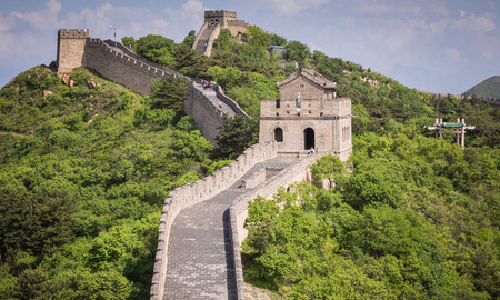
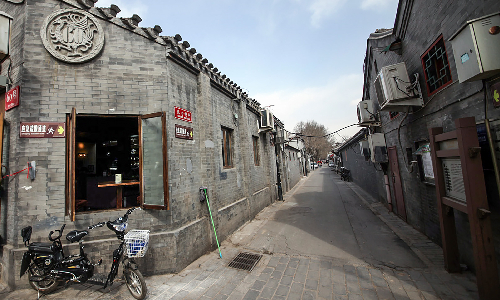
 Xi’an
Xi’an This morning, we will visit the Beijing Zoo, the earliest zoo opened to the public in China. Built in 1906, it is composed of a zoo, a botanical garden, and an agricultural proving ground. Now, it covers an area of about 90 hectares. It exhibits about 500 kinds of rare wild animals and there are more than 5,000 animals here. The zoo receives 5 million visitors from home and abroad every year. Of course, you can see China’s national treasure giant panda here in the Panda House. It covers a total area of 10,000 square meters. The Panda House is divided into three parts for adult pandas, young pandas, and baby pandas. Each part is relatively independent and connected by alleyways, which allow pandas to enter and leave freely. The house is also equipped with isolation rooms, treatment rooms, feed rooms, storage rooms for fresh bamboo, delivery rooms, etc. You will know more about the pandas here. If you want, you can also buy some panda dolls from the souvenir shop. Although you can not take a panada back home, a panda doll is also a good choice.
After lunch, you will be transferred to the railway station in Beijing. Then you will take the estimated train G57 14:00/18:24 to Xi’an. Upon arrival, your tour guide will pick you up there and transfer you to the hotel.
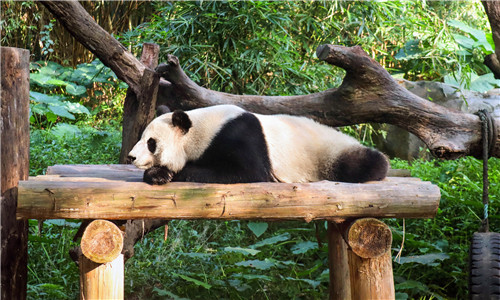
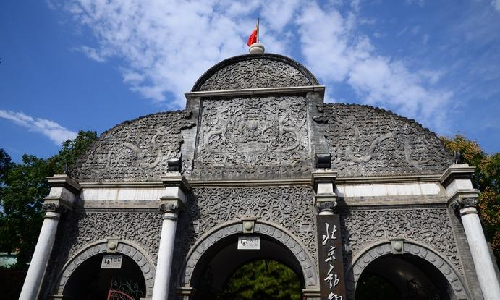
This morning, we will drive eastward for about 50 minutes to the Terra Cotta Warriors and Horses Museum, 40 kilometers away from the center of Xi’an. It is a super large collection of life-size terra cotta sculptures in battle formations, reproducing the mega imperial guard troops of Emperor Qin Shihuang (259-210 BC), the first emperor of China. It is said that the warriors are all made of living people. Is it true? First, each warrior and horse have different facial expressions. Second, many details seem vivid and realistic such as beard, hands, and hairstyles. Third, every warrior has a name engraved on it. However, we can see a lot of rifts on the surface of them. And in fact, it is empty inside the body of the warriors. Therefore, they are obviously made of terra cotta instead of living people.
After lunch, we will visit the Small Wild Goose Pagoda (closed each Tuesday) in Jianfu Temple. It has 13 floors and is 43.4 meters high. There is another attraction called Big Wild Goose Pagoda in Xi’an. The small Wild Goose Pagoda is just three kilometers away from the big one. It is called the Small Wild Goose Pagoda only because of its smaller size. Here we must mention an ancient bell. It is regularly rung in Jianfu Temple every morning. The sound of the ringing bell can be heard for dozens of miles. Isn’t it wonderful to hear such a melodious sound in a modern city?
After visiting the Small Wild Goose Pagoda, we will walk around the old City Wall. It is 13.74 kilometers long and consists of a series of ancient military facilities including the moat, drawbridge, gate tower, arrow tower, main tower, turret, watchtower, battlements, and crenel. In the past, the City Wall served as a shield to defend against the enemy’s attacks. At this moment, it is rated as a well-known tourist attraction. You can stroll on the City Wall and enjoy the sights both inside and outside the city. Then, you will feel the contrast between the historical buildings in the City Wall and the modern skyscrapers outside.
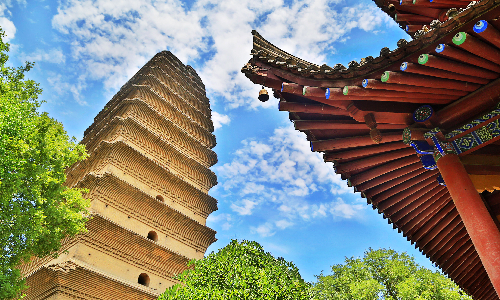
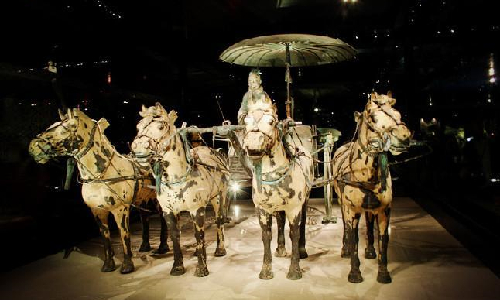
 Dunhuang
Dunhuang This morning, we will visit the Hanyangling Museum. Liu Qi, the fourth emperor of the Western Han Dynasty (202 BC-220 AD), together with his empress was buried here. It took 28 years to complete the tomb. Over the past few years, more than 1,800 pieces of cultural relics have been unearthed. You can see them in the exhibition halls of the museum. Of course, there are many terra cotta figures like what we see yesterday. However, pottery figures in the Hanyangling Museum are colorful, small, and exquisite. You can see female pottery, 41 centimeters high. She has beautiful eyes and black eyebrows like willow leaves. Moreover, she is slender and has an ever-smiling face. She kneels while holding something like glass as if she is serving her owner at a dinner party. The pottery is actually a figure of a well-trained maid. There are other kinds of pottery figures. Let’s go and find the differences between terra cotta figures in Hangyangling Museum and those in the Terra Cotta Warriors and Horses Museum.
After visiting the Hanyangling Museum, you will be transferred to the airport and head to Dunhuang by taking the estimated flight MU9437 15:10/17:40. Your tour guide will be waiting for you at the arrival lobby and then transfer you to the hotel.
The Dunhuang oasis has been a refuge for weary Silk Road travelers since ancient times. Most merchants stayed long enough only to swap a camel. To pray for good fortune, many merchants built the forts, towers, caves and temples scattered over the surrounding areas. These sites, along with the dunes and deserts, make Dunhuang an impressive place to visit. The best time to come to Dunhuang is between May and October. It is arid and rainless all year round. The temperature varies greatly during day and night. Therefore, it’s necessary to bring warm clothes and sunblock and sunglasses.
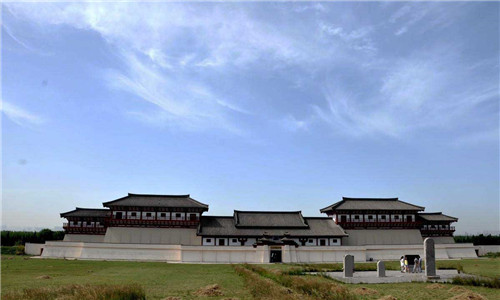
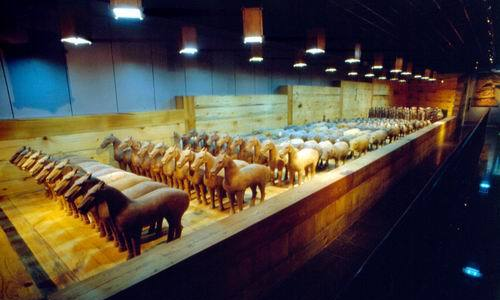
This morning, we will visit the Mogao Grottoes, the largest and richest Buddhist art treasure house in China. With the Echoing Sand Dune as its backdrop, the Mogao Grottoes are surrounded by three dunes. It is 1,600 meters long from north to south. There are now 492 caves, where there are lifelike statues, graceful flying fairies, and exquisite murals, making the Mogao Caves a cultural world full of Buddhist art. It is commonly known as Thousand-Buddha Caves but the word “Thousand” refers to “countless” instead of “one thousand”. It is also known as the “Louvre of the East”. Then do you know the true meaning of its name “Mogao”? “Mo” in Chinese means “desert” and “Gao” means “tall”. It is said that the Mogao Caves were dug in the highland of the Kumtag desert. Therefore, it is named the Mogao Grottoes.
After lunch, we will go to Crescent Lake, which looks like a half-moon. Therefore, it is named Crescent Lake. It is 218 meters long from east to west and 54 meters wide from north to south. The average water depth is about 5 meters. Though the lake is surrounded by dunes, it is still as clear as a mirror. Are you curious about the strange phenomenon? For the special feature of the terrain, the sand grains do not go down the hills when the wind blows. In turn, they flow from the feet of dunes to the top. Thus, Crescent Lake will never be buried by the sand. Isn’t it a desert wonder?
After visiting Crescent Lake, we will go to the Echoing-sand Dune. It covers a total area of 200 square kilometers. We can know from its name that the dune is able to make a sound. Why? Apart from some scientific explanations, there have been many moving legends since ancient times. Legend has it that there was once a lush oasis with water and grass. In the Han Dynasty, a general led his army to the west but their enemy attacked them at night. While the two armies were fighting with each other, a gale blew and then the sand buried all the soldiers and horses of the two armies. Therefore, the Echoing Sand Dune comes into being. It is said that the echoing sound of the dune comes from the sound armies and the neighing of horses.
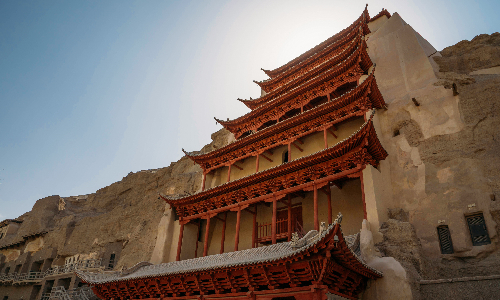
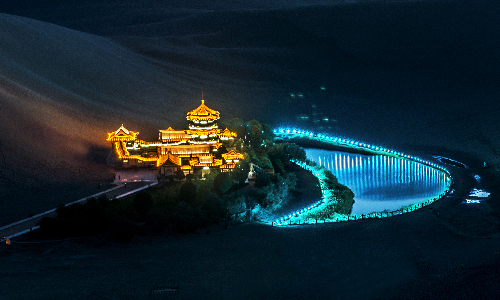
 Turpan
Turpan This morning, we will visit the Yumen Pass, an important military pass on the Silk Road in the Han Dynasty. Commonly known as Small Square Plate City, it was first built by the seventh emperor Liu Che of the Han Dynasty as the Silk Road was set up. Liu Che built the Yumen Pass in order to make it a frontier defense. The word “Yu” in Chinese means “jade”. After the Silk Road was completed, merchants kept passing through the pass and importing beautiful jade from other countries to the Central Plains. Thus, it is named the Yumen Pass which means Jade Gate Pass.
After lunch, you will be transferred to the railway station. Then you will take the estimated train D55 16:35/19:56 to Turpan. Upon arrival, your tour guide will pick you up there and transfer you to the hotel.
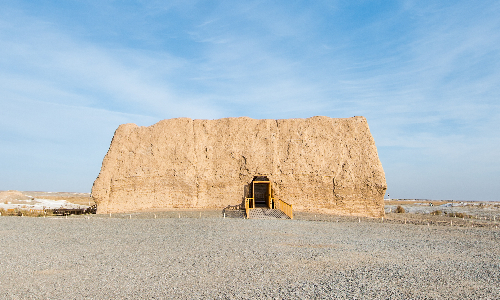
This morning, we will visit the Karez Well. It is the secret why green fruits, vegetables, and crops can grow in the deserts of Turpan. It is extremely dry here so water is very precious for people in Turpan. Thus, people invented the Karez Well to irrigate plants and crops. You will first see a series of mounds on the flat Gobi desert. Most of them are no more than your height and the distance between each other is 20 or 30 meters. Under these dunes, there is a river running all year round. The course of the river is dug by human labor. At a regular distance, a vertical well is set up and connects with the river. It is the delicate well that makes crops grow well in Turpan.
Then we will go to the Beziklik Thousand Buddha Caves at the foot of the Flaming Mountains. It is one of the largest and richest grottoes in Turpan. There are various murals with different themes. In the No. 20 cave, there is a mural of a king and his empress of an area in Turpan. The king wears a lotus-shaped pearl crown, a round-necked gown with wide sleeves, and black boots. On his belt, there are a knife, a flint, and other daily necessities. The Queen is plump, with a crown on her head and a red coat. The mural is brightly colored and vivid even after thousands of years.
After lunch, we will visit the Gaochang Ruins, an ancient city that stands in a desert. It has a history of over 1,300 years. The city lies on high land and open terrain. People here used to live a prosperous life. Therefore, it is named Gaochang City. In Chinese, the word “Gao” means “tall” and “Chang” means “rich and prosperous”. However, we can only see Gaochang Ruins here because the wealthy city was attacked by Mongolian people and other tribes after the 13th century. However, you can still recognize the living area, official area, temple area, and even tomb from the ruins.
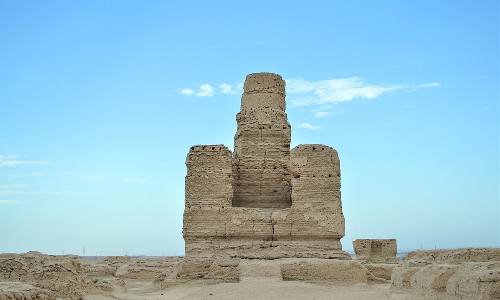
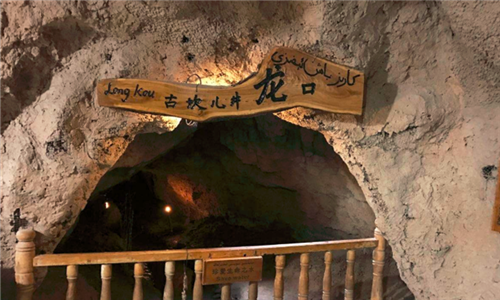
 Urumqi
Urumqi This morning, we will first visit the Sugong Pagoda, a representative architecture of the Uyghur ethnic minority. It is the only well-preserved and the largest ancient pagoda of Islamic architecture in China. It is a huge cone tower built of grayish-yellow bricks. The surface of the Sugong Pagoda is covered with 15 kinds of Uygur traditional geometric patterns, such as triangle, four-petal form, water ripples shape, and diamond shape. In the pagoda are heavy columns made of gray bricks. What’s more, the dome of the pagoda has Islamic features which are unique and attractive. If you are interested in Islam, you must not miss the attraction.
After visiting the Sugong Pagoda, we will go to the Jiaohe Ruins. Jiaohe was once one of the most prosperous cities on the ancient Silk Road. It has the same reputation as the ancient Loulan country, a hub of the Silk Road. It is also known as the “Oriental City of Pompeii”. However, the Mongolian nobles launched a war in the late 13th century, and then the city of Jiaohe was attacked and it became ruins in the war in 1383. There is a strange cemetery in the Jiaohe Ruins. Hundreds of rectangular graves are put in order and hundreds of babies are buried here. People call the cemetery “Babies’ Graves”. There are no names and epitaphs in front of the graves. You can imagine how grieved the parents were when their children died at a very early age. There are many mysteries like the Babies’ Graves in the Jiaohe Ruins. Let’s go to explore them!
After lunch, you will be transferred to the railway station in Turpan. Then you will take the estimated train D8807 17:35/18:30 to Urumqi. Upon arrival, your local tour guide will pick you up and transfer you to the hotel.
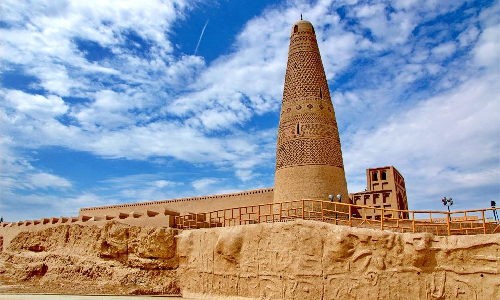
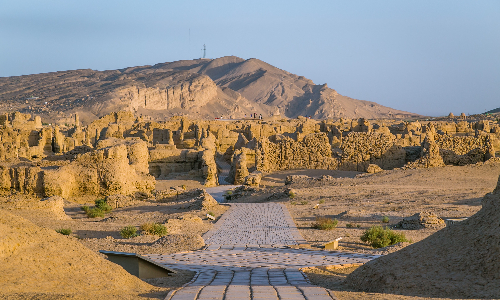
 Kashgar
Kashgar This morning is free for you, so you are allowed to walk around near the hotel and look around Urumqi.
Then you will be transferred to the airport and head to Kashgar by taking the estimated flight CA1477 13:30/15:30. Your tour guide will wait for you at the arrival lobby and then transfer you to the hotel.
This morning, we will visit the Id Kah Mosque, the largest mosque in Xinjiang. It covers a total area of 16,800 square meters. In 1538, the then supreme ruler of Kashgar built a small mosque in memory of his uncle who was buried here. The mosque was the predecessor of the Id Kah Mosque. Then it got several times rebuilding and then became what you see now. While visiting the mosque, it is necessary to remember that you should never stand in front of a Muslim while they worship. Besides, do not make noise in the Id Kah Mosque. Last, Friday services are closed to non-Muslims. Only when you get permission can you enter it.
Then we will visit the Abakh Hoja Tomb, which looks like a magnificent palace. It covers a total area of two hectares. We can know from the name of the tomb that the family members of Abakh Hoja are buried here. It is said that a girl in this family was selected to be the concubine of Emperor Qianlong. She was born with a fragrance. So she is called “fragrant concubine”, also named “Xiang Fei”. After she died, Emperor Qianlong allow her family to take her home. And she was also buried in Abakh Hoja Tomb. Her Tomb is located at the northeast corner, with her name written in Uygur and Chinese in front of the tomb. The tomb mound is covered with blue glass bricks and colorful cloth. This is not only to show respect for the dead but also to protect the tomb. There are two elaborate mosques on the left of Xiang Fei’s Tomb. It has dramatic scenery around it.
Last, we will go to the Kashgar Old City, a must-go attraction in Kashgar. It is said that if you do not visit Kashgar, you have not really been to Xinjiang; if you do not visit the Kashgar Old City, you have not really been to Kashgar. The once affluent city was attacked by wars. Besides, many people dug the ground to find gold in the past. Therefore, the city was damaged a lot. What’s worse, most of the residential buildings were made of sand, bricks, and wood. Thus, they were so vulnerable that an earthquake could destroy them easily. In 2010, however, the local government approved to renovate the Kashgar. Nowadays, it covers 8 square kilometers and is home to 220,000 people. Walking in the old city, you can still see its prosperity and experience its culture in person.
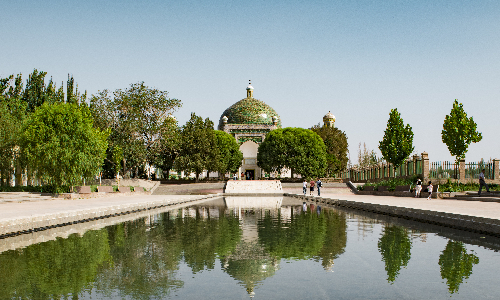
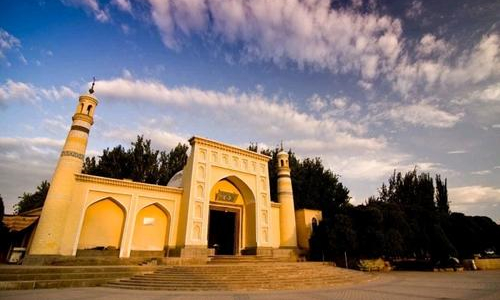
 Shanghai
Shanghai This morning, we will go to the Kashgar Grand Bazaar, the largest international trade market in northwest China. It covers an area of 17 hectares. In fact, there are so many bazaars in Kashgar. According to their functions, they are divided into the straw bazaar, carpet bazaar, cloth bazaar, livestock bazaar, knife bazaar, dried fruit bazaar, and so on. Here you can buy everything you want and you can also experience the ancient trading ways. Are you excited to join the crowd and walk around the Kashgar Grand Bazaar? Before you come to the large market, here are two tips for you. First, take care of your personal belongings and do not leave your valuables on the stalls. Second, you can try to bargain with the vendor. And maybe you will get the goods at a much nicer price. Wish you have a good time.
After lunch, you will be transferred to the airport and head to Shanghai by taking the estimated flight CZ6997 14:20/22:00. Your tour guide will wait for you at the arrival lobby and then transfer you to the hotel.
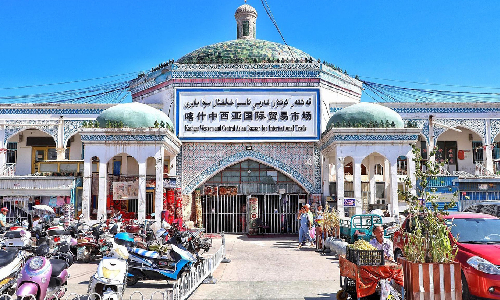
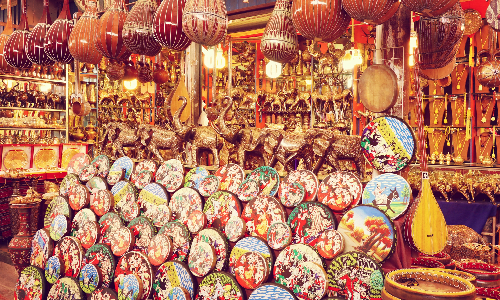
This morning, we will visit the Yu Garden (closed each Monday), a private garden built in the Ming Dynasty. It has a history of over 450 years. The word “Yu” in Chinese means to make parents live a cozy and happy life. There is a famous stone named Exquisite Jade Rock in the garden. there are more than 70 natural holes on the stone which make this stone looks distinctively shaped. As an important place of cultural activities, there will be different decorations for different festivals in the Yu Garden. When the Lantern Festival is coming, people can walk around the Yu Garden and watch colorful lanterns. You can also take your beloved one here to feel the Chinese culture. Isn’t it romantic?
Then we will go to the Jing’an Temple, the oldest Buddhist Temple in Shanghai. It covers a total area of 22,000 square meters. Its biggest feature is that it’s a very quiet place in the noisy and international city. There are not only temples but pagodas. The most striking building in the temple is the Jing’an Pagoda, which is a rare square pagoda. It is seven stories high and is painted with red and gold color. Another feature of the temple is that there is a Buddhist academy. Therefore, people can study Buddhist culture here.
After lunch, you will be driven to the Oriental Pearl TV Tower. It is 468 meters high and covers a total area of 100,000 square meters. There are five viewing platforms in the Oriental Pearl TV Tower and they are good places to take a bird’s-eye view of the scenery of Shanghai. There is also a revolving restaurant in the tower. The restaurant can rotate 360 degrees and it is 267 meters high. It has gained fame as the highest revolving restaurant in Asia. Let’s go and experience the amazing height!
Then we will go to the Bund. The Bund, also called Waitan, is a famous waterfront on the west bank of Huangpu River and is deemed as the symbol of Shanghai. Here, the charm of Shanghai as a bustling metropolis combining the century-old history and flourishing future is fully presented, making the Bund a must-see attraction. Don’t forget to take photos here and share them on your FB. I am sure you will get a lot of “like”.
The last attraction is Nanjing Road, the most prosperous street in Shanghai. It has won its reputation as “the first commercial street in China”. There are over 500 stores so you can eat delicious food and buy things for your friends and family members. Here you could eat wonton, rice balls, pan-fried buns stuffed with pork, noodles with chili soybean paste, and so on. What’s more, you can go to Shen Da Cheng to buy mooncakes with meat fillings; or you can choose to go to Shanghai First Food Hall to buy local snacks. Since there are so many foods waiting for you to taste, what are you waiting for?
You may be very tired after a busy day. Thus, you do not want to eat dinner in a far place. Don’t worry, as our all inclusive China tour will arrange the dinner Dim Sum for you. It is a meal of small dishes served with tea comprised of a collection of savory fried buns, dumplings, and rolls. After dinner, you will come back to the hotel and have a good rest. It’s worth mentioning that ordinary tourists won’t have Dim Sum for dinner. Only the tourists in this all inclusive tour will enjoy such a nice dinner. Therefore, what are you waiting for? Come on and join us soon.
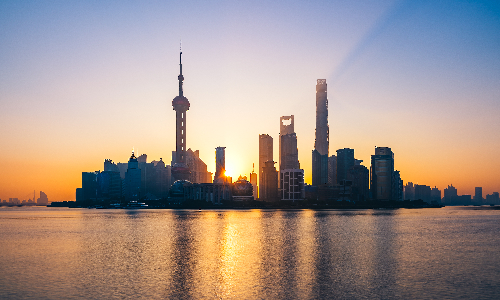
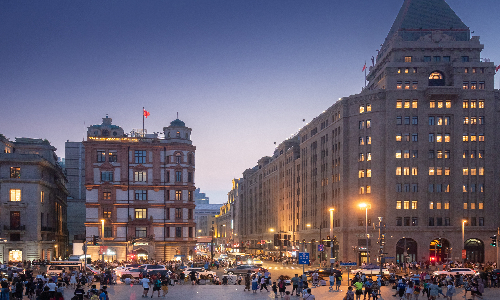
Today your 15-day All Inclusive China Tour comes to an end. Your tour guide will accompany you to the airport and say goodbye to you. Then you will board your flight back home.
Author: Zhang Liya
Proofreader: Betsy He
| City | Five Star hotel list | Four Star hotel list |
|---|---|---|
| Beijing | Sunworld Dynasty Hotel Beijing Wangfujing | Sunworld Hotel Wangfujing |
| Xi'an | Tianyu Gloria Grand Hotel Xi'an | Sunworld Dynasty Hotel |
| Dunhuang | Wan Sheng International Hotel | Grand Sun Hotel Dunhuang |
| Turpan | Jinjiang Metropolo Hotel - Turpan Administration Center | Mercure Hotel Turpan Downtown |
| Urumqi | Grand Mercure Urumqi Hualing | Tumaris Hotel |
| Kashgar | Yue Xing Jin Jiang International Hotel | Tianyuan International Hotel |
| Shanghai | Ocean Hotel Shanghai | Courtyard by Marriott Shanghai Central |
 |
![]() About your child or infant, please contact us for a discounted price.
About your child or infant, please contact us for a discounted price.



We started with a few days in Beijing & ended in Shanghai, from where we visited the Forbidden City and Great Wall. In between we visited Terra Cotta Warriors Museum, Panda Base, Shanghai Disneyland.

We had a wonderful holiday in China which will remain long in the memory. China is a breathtakingly beautiful country full of splendid temples and palaces, mountains and rivers, peaceful rural scenes and bustling shopping streets.
 QUICK ENQUIRY
QUICK ENQUIRY